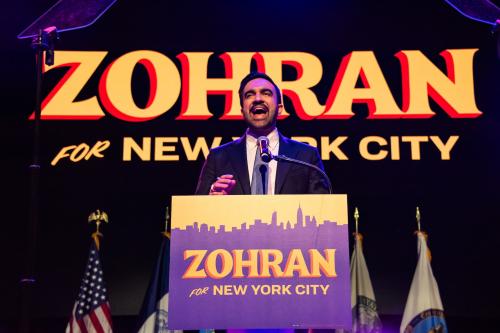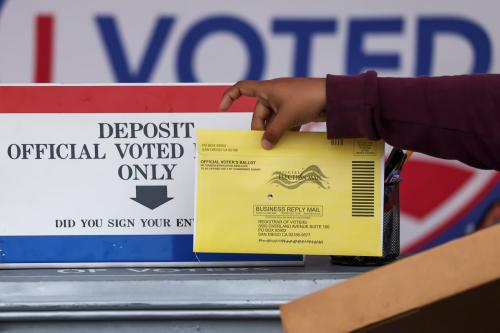There are three possible outcomes in the contest for the Republican presidential nomination (assuming that there are no major changes in the party’s draft rules for the convention.)
Outcome #1: Donald Trump wins the required majority of 1237 delegates outright by June 7, when voters from California and New Jersey weigh in;
Outcome #2: Trump gets so close that he can close the deal by negotiating with unpledged delegates between June 7 and the beginning of the Republican convention in mid-July;
Outcome #3: Trump fails to enter the convention with a majority and must bet everything on a first-ballot victory (no one thinks he would be stronger on the second ballot than on the first.)
For some time, most observers have thought that the third outcome—a convention fight—is the most likely. They should reconsider. A state-by-state analysis suggests that even if Mr. Trump doesn’t go over the top on June 7, he will come close enough that he can pick off the necessary number of unpledged delegates pretty quickly. Consider the following:
By winning about 90 of New York’s 95 delegates on Tuesday, his delegate count now stands at 845. The remainder of the April contests—in Connecticut, Delaware, Maryland, Pennsylvania, and Rhode Island—are likely to go his way as well. Taken together, these states will award 60 delegates to the state-wide winner and another 39 to the winner of congressional districts. Rhode Island goes its own way, dividing its statewide delegates proportionally and its congressional district delegates to candidates who clear a 10% threshold. And only 17 of Pennsylvania’s 71 delegates will be pledged; the state will also select 54 unbound delegates who will be free to exercise their own judgment, at or before the convention. That said, Mr. Trump seems sets to end the month of April with about 925 delegates—more if his statewide victory margins are big enough to sweep most of the congressional districts.
The pace slows considerably in May, with only five primaries and a total of 199 delegates at stake. Four of those primaries are easy to predict. Nebraska is Cruz territory; Trump should run the table in West Virginia; Oregon and Washington, which divide their statewide delegates proportionally and (in the case Washington, congressional districts through a complex formula) should yield delegates for all three candidates. The central case projection: Trump wins 63 delegates in these four primaries.
That leaves Indiana, now the object of much attention. Indiana will award 30 of its 57 delegates to the statewide winner, while the winner of each of its 9 congressional district receives 3 delegates. The state’s demographics point to a very close race between Trump and Cruz. Depending on how the statewide contest goes, Trump could gain either 12 or 45 delegates.
So putting all the May contests together leaves the New York billionaire with between 1000 and 1033 delegates.
Then comes June 7, when the final five primaries and 303 delegates are up for grabs. As in May, four of the five are pretty easy to project. New Jersey, Montana, and South Dakota are winner-take all states. Based on trends so far, Trump should come away with New Jersey’s 51 delegates; Cruz with Montana’s 27 and South Dakota’s 29. New Mexico divides its 24 delegates proportionally, with a 15% threshold; Trump and Cruz should divide the lion’s share, with Kasich in the running to collect a few if he clears the threshold. Given these assumptions, Trump would have between 1061 and 1094 delegates.
That leaves California, with its massive haul of 172 delegates. Only 13 are awarded to the statewide winner; 3 delegates go to the winner of each of the state’s 53 congressional districts. For what it’s worth, the most recent CBS/YouGov survey, with a large sample of 1012 likely voters, gave Trump 49% of the vote, compared to 31% for Cruz and 16% for Kasich. If Trump wins a plurality on June 7, he should receive well more than half the delegates. How much more of the delegates he gets will depend not only on his victory margin, but also the geographical distribution of his votes. Given these assumptions, he should come away from the Golden State with a minimum of 109 delegates (13 statewide plus 96 from 32 congressional districts).
This result would leave him with a minimum of 1170 delegates, only 67 short of outright victory.
The bottom line: making conservative assumptions about the two states—Indiana and California—whose outcome is least predictable, Trump comes close enough to be in a strong position to negotiate his way to 1237. If he does better in one of those states, his negotiating position will be even stronger. If he exceeds the baseline in both, he goes over the top on June 7. Of course, there’s always the possibility that the delegates, once assembled, could find a way to deviate from the primary vote. In that case we’re in for an historic convention.
The Brookings Institution is committed to quality, independence, and impact.
We are supported by a diverse array of funders. In line with our values and policies, each Brookings publication represents the sole views of its author(s).




Commentary
Three possible outcomes for the Republican presidential nomination
April 22, 2016